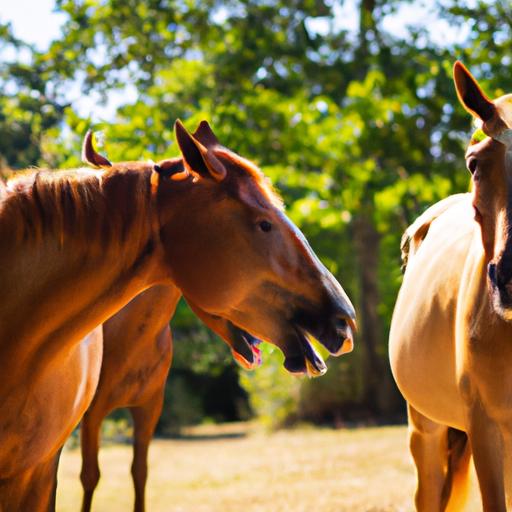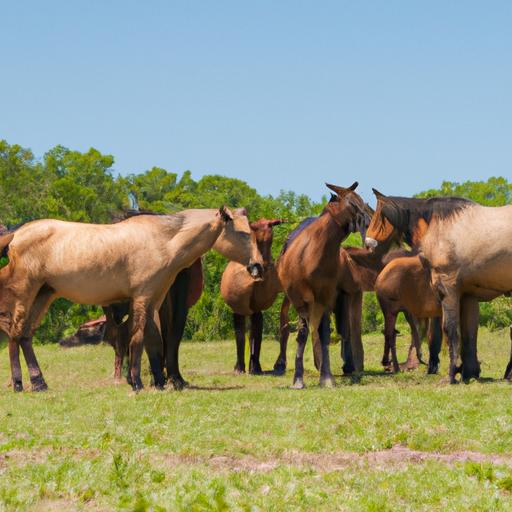Unlock the secrets of horse behavior with our captivating PowerPoint presentations. Learn effective tips for engaging your audience and delivering a successful horse behavior ppt.
Introduction

Have you ever wondered what goes on in the mind of a horse? Understanding horse behavior is not only fascinating but also crucial for anyone involved in equine care or training. Whether you’re a passionate equestrian, a horse owner, or a professional in the field, grasping the intricacies of horse behavior can significantly enhance your interactions and create a harmonious bond with these majestic creatures. In this article, we delve into the world of horse behavior and explore how PowerPoint presentations can aid in comprehending and conveying this knowledge effectively.
The Importance of Understanding Horse Behavior
Horses are inherently social animals with complex behavioral patterns shaped by centuries of evolution. By comprehending their behavior, we can better understand their needs, desires, and emotions, promoting their overall well-being and welfare. Additionally, a deep understanding of horse behavior allows us to establish better communication and develop mutual trust, leading to safer and more successful interactions.
The Purpose of This Article
The purpose of this article is to guide you on how to utilize PowerPoint presentations to effectively communicate and teach horse behavior. We will explore the benefits of using this visual medium and provide practical tips to create and deliver compelling presentations that captivate your audience. Whether you’re an educator, trainer, or simply passionate about horses, this article will equip you with the tools and techniques to enhance your teaching and engagement.
As we dive into the world of horse behavior and PowerPoint presentations, get ready to unlock the secrets of equine communication. Together, we will embark on a journey to unravel the intricate language of horses while discovering the power of visual aids in conveying this knowledge effectively. So, let’s saddle up and explore the fascinating realm of horse behavior through the lens of PowerPoint presentations.
Stay tuned for the next section, where we will delve into the fundamental aspects of horse behavior, unraveling their natural instincts and herd dynamics.
Understanding Horse Behavior
Natural Instincts and Herd Dynamics
Horses are remarkable creatures shaped by their natural instincts and herd dynamics. Instincts developed over thousands of years of evolution drive their behavior. Understanding these instincts is crucial in comprehending their reactions and responses to various situations.
In their natural environment, horses are social animals that form strong bonds within a herd. They have a hierarchical structure where a dominant leader, often referred to as the alpha or herd leader, guides the group. This hierarchy ensures order and safety within the herd.
Communication Methods Used by Horses
Horses communicate with each other using a sophisticated language of body gestures, vocalizations, and facial expressions. By understanding these communication methods, we can decipher their intentions and emotional states. Common communication signals include:
-
Body Language: Horses use body movements such as ear position, tail swishing, and body posture to convey their emotions and intentions. For example, a relaxed and forward-leaning posture indicates a content and confident horse, while pinned ears and a tense body may signify aggression or fear.
-
Vocalizations: Horses also vocalize to communicate. Whinnies, neighs, snorts, and nickers are some of the sounds they produce. Each vocalization carries a specific meaning, such as a welcoming nicker to greet a familiar companion or a high-pitched whinny as a distress call.
-
Facial Expressions: Just like humans, horses display emotions through their facial expressions. They use their eyes, nostrils, and mouth to convey their feelings of fear, relaxation, curiosity, or aggression. Observing these subtle cues can provide valuable insights into their emotional state.
Factors Influencing Horse Behavior
Various factors influence horse behavior, including:
-
Genetics: Different horse breeds exhibit distinct behavior traits due to their genetic makeup.
-
Past Experiences: Horses can be influenced by their past experiences, such as previous training methods or traumatic events, which may shape their behavior and responses.
-
Environment: The physical environment, such as the type of stabling, turnout, or presence of other animals, can impact a horse’s behavior.
-
Training and Handling: The way a horse is trained and handled significantly affects its behavior. Positive reinforcement and gentle handling techniques can foster trust and cooperation, while harsh or inconsistent training methods may lead to anxiety and resistance.
By understanding these fundamental aspects of horse behavior, we lay a solid foundation for further exploration into the world of equine communication. In the next section, we will explore the benefits of utilizing PowerPoint presentations to enhance our understanding and teaching of horse behavior. So, get ready to dive into the world of visual aids and their impact on equine education.
Benefits of Using PowerPoint Presentations for Horse Behavior
In today’s digital age, PowerPoint presentations have become a powerful tool for effectively conveying information and engaging audiences. When it comes to teaching horse behavior, utilizing PowerPoint presentations offers numerous benefits that can significantly enhance the learning experience. Let’s explore some of these advantages:
Visual Aids Enhance Understanding
Horse behavior can be complex, with various nuances and subtle cues that are not easily explained through words alone. By incorporating visual aids such as images, diagrams, and videos into your PowerPoint presentations, you can provide a visual representation of different behaviors, gestures, and body language. These visuals offer a clearer understanding of concepts, helping your audience grasp the intricacies of horse behavior more easily. Visuals also have a lasting impact on memory retention, making the information more memorable and reinforcing the learning experience.
Engaging and Interactive Learning Experience
PowerPoint presentations allow for a dynamic and interactive learning experience. You can create interactive slides that involve your audience through quizzes, polls, or open-ended questions. This engagement not only keeps the audience actively involved but also encourages critical thinking and deeper understanding of the subject matter. By incorporating interactive elements, you transform your presentation into a two-way conversation, fostering a sense of connection and collaboration.
Organized and Structured Information Delivery
One of the key advantages of PowerPoint presentations is their ability to organize and structure information in a visually appealing manner. You can create well-defined sections, headings, and bullet points that guide the flow of your presentation, ensuring a logical progression of ideas. This organization helps your audience follow along with ease, preventing information overload and confusion. By presenting information in a structured format, you can effectively convey the key points of horse behavior, making it easier for your audience to absorb and retain the information.
As we have seen, PowerPoint presentations offer a range of benefits when teaching horse behavior. From enhancing understanding through visual aids to creating an engaging and interactive learning experience, this medium allows you to effectively convey the intricacies of equine communication. In the next section, we will dive into the process of creating an effective horse behavior PowerPoint presentation, focusing on content selection and design. So, get ready to unleash your creativity and captivate your audience with a compelling presentation that brings horse behavior to life.
Creating an Effective Horse Behavior PowerPoint Presentation
Choosing the Right Content and Topics
When developing a horse behavior PowerPoint presentation, it is crucial to select relevant and engaging content that aligns with your audience’s interests and knowledge level. Consider the key aspects of horse behavior you want to convey and structure your presentation accordingly. Break down complex concepts into digestible segments, ensuring a logical flow that builds upon previous information. By organizing your content effectively, you can keep your audience focused and captivated throughout the presentation.
Designing Visually Appealing Slides
Visual appeal plays a vital role in capturing your audience’s attention and conveying information effectively. Keep your slides clean, uncluttered, and visually appealing by utilizing a consistent color scheme, complementary fonts, and appropriate imagery. Incorporate high-quality photographs, diagrams, and illustrations that enhance understanding and create a visually stimulating experience. Remember, a well-designed slide can reinforce your message and make a lasting impact on your audience.
Incorporating Multimedia Elements
To further enhance engagement, consider incorporating multimedia elements into your horse behavior PowerPoint presentation. Videos, audio clips, and animations can provide a dynamic and interactive experience, making the learning process more enjoyable and memorable. For example, showcasing video footage of horses displaying certain behaviors or using sound effects to simulate their vocalizations can create a multisensory experience that deepens the understanding of equine behavior.
Utilizing Appropriate Fonts and Colors
The choice of fonts and colors can significantly influence the overall look and feel of your presentation. Opt for clear and legible fonts to ensure readability, avoiding overly decorative or complex styles that may distract the audience. Additionally, choose colors that complement each other and align with the theme and content of your presentation. Consistency in font styles and color schemes throughout your slides will provide a cohesive and professional visual experience.
As you embark on creating your horse behavior PowerPoint presentation, remember that a well-structured and visually appealing presentation can effectively convey the intricate world of equine behavior. Stay tuned for the next section, where we will explore tips for delivering a successful horse behavior PPT, ensuring that your presentation captivates and educates your audience effectively.
Conclusion: Enhancing Equine Understanding with Horse Behavior PPT
In conclusion, understanding horse behavior is paramount for anyone involved in the equestrian world. By unraveling the intricate language of horses, we can foster better communication, establish trust, and ensure their well-being. Incorporating PowerPoint presentations into your educational endeavors can elevate your teaching and engagement, making the learning experience more immersive and impactful.
Throughout this article, we have explored the importance of understanding horse behavior and how PowerPoint presentations can enhance the delivery of this knowledge. From grasping natural instincts and herd dynamics to harnessing the power of visual aids, we have delved into the various components of creating an effective horse behavior PPT. By choosing the right content, designing visually appealing slides, and incorporating multimedia elements, you can captivate your audience and facilitate a deeper understanding of equine behavior.
Moreover, we have provided valuable tips for delivering a successful horse behavior PPT. Rehearsing your presentation, engaging the audience through storytelling, utilizing effective body language and tone, and encouraging participation are all key elements in creating an engaging and interactive learning experience. By incorporating these strategies, you can ensure that your message resonates with your audience, leaving a lasting impact on their understanding of horse behavior.
In your quest to become a proficient horse behavior educator, remember that Horsemasterypro.com is your trusted companion. Our mission is to provide you with the knowledge and tools necessary to enhance your horsemanship skills. So, saddle up and embark on this journey of discovery, as we unveil the secrets of equine communication and deepen our bond with these magnificent creatures.
Remember, understanding horse behavior is not just a skill; it’s a lifelong journey. By continuously expanding our knowledge, refining our teaching techniques, and embracing the power of PowerPoint presentations, we can become ambassadors for equine understanding and advocates for the well-being of horses everywhere.
Thank you for joining me in this exploration of horse behavior and PowerPoint presentations. Keep learning, keep growing, and together, let’s make a positive impact on the world of horsemanship.


